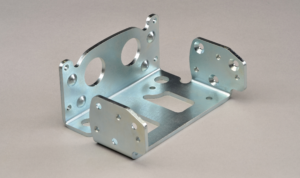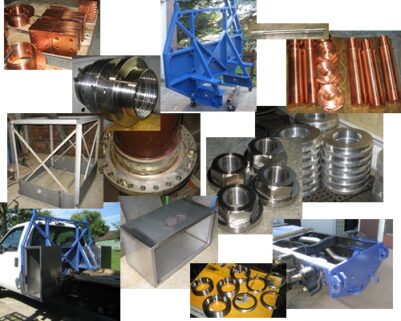Fourslide Components

Four-slide (fourslide) fabrication is a metal forming process in which flat stock sheet metal or wire is shaped into predetermined parts in a stamping press. During the press operation, the slide or ram, maintains movement to and from a motionless table called a press bed. The die, a press tool consisting of a specially designed cavity, shapes metal parts from the inserted sheet metal. The upper component of the die connects to the press slide and the lower component connects to the press bed. A die component called the punch performs the necessary shaping operation by pushing the sheet metal through the die. Dies slide in and out from four sides (thus the name Four-slide, Fourslide) to make multiple, precision bends.
Examples of Four-Slide (Fourslide) Parts:

A four-slide (fourslide) machine is much different than most other presses. The main feature of the machine is its moving slides that have tools attached, which strike the workpiece to form it. These slides are driven by four shafts that outline the machine. The shafts are connected by bevel gears so that one shaft is driven by an electric motor, and then that shaft’s motion drives the other three shafts. Each shaft then has cams which drive the slides, usually of a split-type. This shafting arrangement allows the workpiece to be worked for four sides, which makes this machine extremely versatile. A hole near the center of the machine is provided to expel the completed workpiece.
Typical Four-slide (Fourslide) Machine Operation:

Due to this flexibility, it reduces the cost of the finished part because it requires less machines, setups and handling. Also, because only one machine is required, less space is required for any given workpiece. As compared to standard stamping presses, the tooling can be more or less expensive depending on the complexity of the parts. A four-slide can usually produce 20,000 to 70,000 finished parts per shift, depending on the number of operations per part. This production speed usually results in a lower cost per part.
Although the piece price of a four-slide manufactured part is relatively inexpensive, hard tooling is required to form the parts and the tooling could be quite expensive depending on the complexity of the part, as mentioned above.
Metal Stamping

Metal Stamping (forming) is the process of placing flat sheet metal in either blank or coil form, into a stamping press where a tool and die surface forms the metal into a net shape. This could be a single stage operation where every stroke of the press produces the desired form on the sheet metal part, or could occur through a series of stages. The process is usually carried out on sheet metal, but can also be used on other materials. Metal stamping can include a number of metal forming processes; blanking, punching, bending, and piercing and more.
Blanking: This process is about cutting the rough outline or shape of the product. This stage is about minimizing and avoiding burrs, which can drive up the cost of your part and extend lead time. The step is where you determine hole diameter, geometry/taper, the spacing between edge-to-hole and insert the first piercing.

Bending: When you are designing the bends into your stamped metal part, it is important to allow for enough material — make sure to design your part and its blank so that there is enough material to perform the bend. Some important factors to remember:
- If a bend is made too close to the hole, it can become deformed.
- Notches and tabs, as well as slots, should be designed with widths that are at least 1.5x the thickness of the material. If made any smaller, they can be difficult to create due to the force exerted on punches, causing them to break.
- Every corner in your blank design should have a radius that is at least half of the material thickness.
- To minimize instances and severity of burrs, avoid sharp corners and complex cutouts when possible. When such factors cannot be avoided, be sure to note burr direction in your design so they can be taken into account during stamping
Coining: This action is when the edges of a stamped metal part are struck to flatten or break the burr; this can create a much smoother edge in the coined area of the part geometry; this can also add additional strength to localized areas of the part and this can be utilized to avoid secondary process like deburring and grinding. Some important factors to remember:
Examples of Stamped Parts:

Springs

A spring is defined in its most simplest form as an elastic device used to store energy. Springs are usually made from coiled spring steel wire. There are a large number of spring designs, broken down into three primary categories; compression, extension and torsion.




Compression Springs Extension Springs Torsion Springs Constant Force Springs
There is a fourth, less common category, “constant force springs” such as those found in a tape measure. Springs can be made out of round, flat or square wire. Small springs can be wound from “pre-hardened” wire stock while larger springs are made from “annealed steel wire” and hardened after fabrication. Some non-ferrous metals are also used, including phosphor bronze and titanium, for parts requiring corrosion resistance and beryllium copper for springs carrying electrical current (because of its low electrical resistance).
When a coil spring is compressed or stretched slightly from rest, the force it exerts is approximately proportional to its change in length. The “Rate” of a spring is the change in the force it exerts, divided by the change in its deflection. A compression or extension spring has “Units of Force” divided by distance. A torsion spring has “Units of Torque” divided by angle and degree. The inverse of Spring Rate is Compliance.
Depending on the design and required operating environment, any material can be used to construct a spring, so long as the material has the required combination of rigidity and elasticity.
Industries We Serve; Components, Parts and Services We Provide – CLICK HERE
-
- Aircraft Component Parts and Supplies
- Biotech Machined Components Parts and Fasteners
- Construction Fasteners, Supplies and Tools
- Defense & Military Fasteners, Hardware and Machined Component Parts
- Electrical Connectors, Insulators, Lugs, Terminal Blocks, Assorted Supplies
- Firearms Machined Components Parts and Fasteners
- Food & Beverage Fasteners, Machined Component Parts, Fasteners and Supplies
- Medical Machined Components Parts, Fasteners and Supplies
- Oil Field and Energy Components Parts and Fasteners and Supplies
- Water Filtration and Distribution Injection Molding, Machined Components, Fasteners and Supplies
PLEASE CALL US FOR QUESTIONS OR A QUOTE: (916) 202-1104 TOLL FREE FAX LINE: (866) 265-0011 or Email Us
